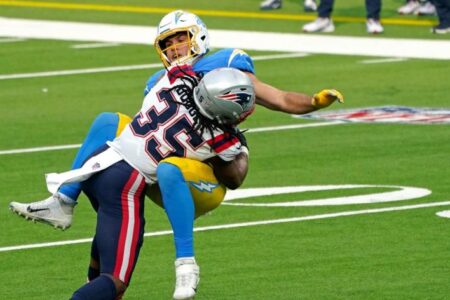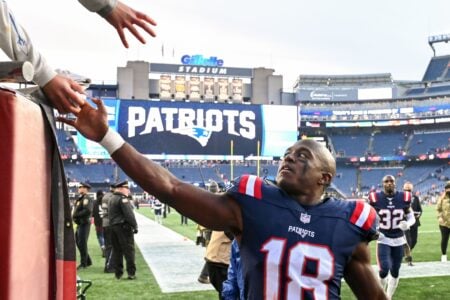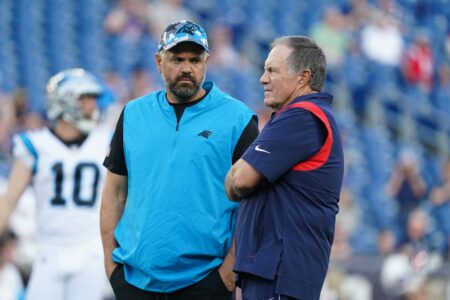arrellbee
Rotational Player and Threatening Starter's Job
- Joined
- May 11, 2005
- Messages
- 1,084
- Reaction score
- 0
I guess the first question is whether the Patriots would even want to trade a 2nd round pick and change for a 1st round pick.
You would have to think the empirical evidence says that they don't see the value in that.
-----------------------
Evaluating what value you get for the cap dollar in the draft seems to fit the Patriots value method of filling in their whole 53 man roster. So that may provide some perspective on why they might not be all that interested in first round picks, especially any picks above the bottom of the 1st round.
I doubt there would be too much disagreement among the veterans of the board that high round one picks, and of course epitomized by the 1st pick of the first round, have almost no chance of yielding value to the team anywhere near the money spent on their rookie contracts.
It may well also be that even low 1st round picks above #25 might also not be that good of a value.
In roughly 2006, a couple guys did a pretty sophisticated analysis of what contribution teams got from picks in the first few rounds versus the money teams had to spend for those picks. The basis for establishing the value was the history of players drafted in particular positions over a significant number of years. The factors used to determine the value were predominantly how many games the player started, followed by how many games the player played in, followed by Pro Bowl appearances.
Using their value for the dollar metrics, one media pundit summarized this draft as:
"Looking at this year’s scores, the four big winners were, in order, the Patriots, the Denver Broncos, the Lions and the Giants. "
Link to whole article:
NFL Draft Signals Giants-Patriots Super Rematch: Kevin Hassett - Bloomberg.com
Going back to the 2006 statistical paper, the bottom line is that the best value for the dollar is right at the 35th pick at the top of the 2nd round. Of course, the Pats first pick was at 34.
The top of the value for the dollar curve stretches from roughly 25th through 40th pick, peaking at the 35th pick. Of course the Pats next two picks were at 40 and 41.
The Pats pick at 58 was down the curve as far as value for dollar goes. But since the curve drops off as you go back higher into the first round also since those picks cost so very much, the 58th pick has a roughly identical value for dollar with the 12th pick of the draft according to their statistical analysis.
So all of these picks high on the value for dollar curve were what led to the analysis that the Patriots got the best value draft this year.
The original paper published is very long and full of jargon until you get down to the summary section and their graphs. In case anybody is in the slightest interested, here's the link:
http://www.econ.berkeley.edu/~webfac...p06/Thaler.pdf
You would have to think the empirical evidence says that they don't see the value in that.
-----------------------
Evaluating what value you get for the cap dollar in the draft seems to fit the Patriots value method of filling in their whole 53 man roster. So that may provide some perspective on why they might not be all that interested in first round picks, especially any picks above the bottom of the 1st round.
I doubt there would be too much disagreement among the veterans of the board that high round one picks, and of course epitomized by the 1st pick of the first round, have almost no chance of yielding value to the team anywhere near the money spent on their rookie contracts.
It may well also be that even low 1st round picks above #25 might also not be that good of a value.
In roughly 2006, a couple guys did a pretty sophisticated analysis of what contribution teams got from picks in the first few rounds versus the money teams had to spend for those picks. The basis for establishing the value was the history of players drafted in particular positions over a significant number of years. The factors used to determine the value were predominantly how many games the player started, followed by how many games the player played in, followed by Pro Bowl appearances.
Using their value for the dollar metrics, one media pundit summarized this draft as:
"Looking at this year’s scores, the four big winners were, in order, the Patriots, the Denver Broncos, the Lions and the Giants. "
Link to whole article:
NFL Draft Signals Giants-Patriots Super Rematch: Kevin Hassett - Bloomberg.com
Going back to the 2006 statistical paper, the bottom line is that the best value for the dollar is right at the 35th pick at the top of the 2nd round. Of course, the Pats first pick was at 34.
The top of the value for the dollar curve stretches from roughly 25th through 40th pick, peaking at the 35th pick. Of course the Pats next two picks were at 40 and 41.
The Pats pick at 58 was down the curve as far as value for dollar goes. But since the curve drops off as you go back higher into the first round also since those picks cost so very much, the 58th pick has a roughly identical value for dollar with the 12th pick of the draft according to their statistical analysis.
So all of these picks high on the value for dollar curve were what led to the analysis that the Patriots got the best value draft this year.
The original paper published is very long and full of jargon until you get down to the summary section and their graphs. In case anybody is in the slightest interested, here's the link:
http://www.econ.berkeley.edu/~webfac...p06/Thaler.pdf


















